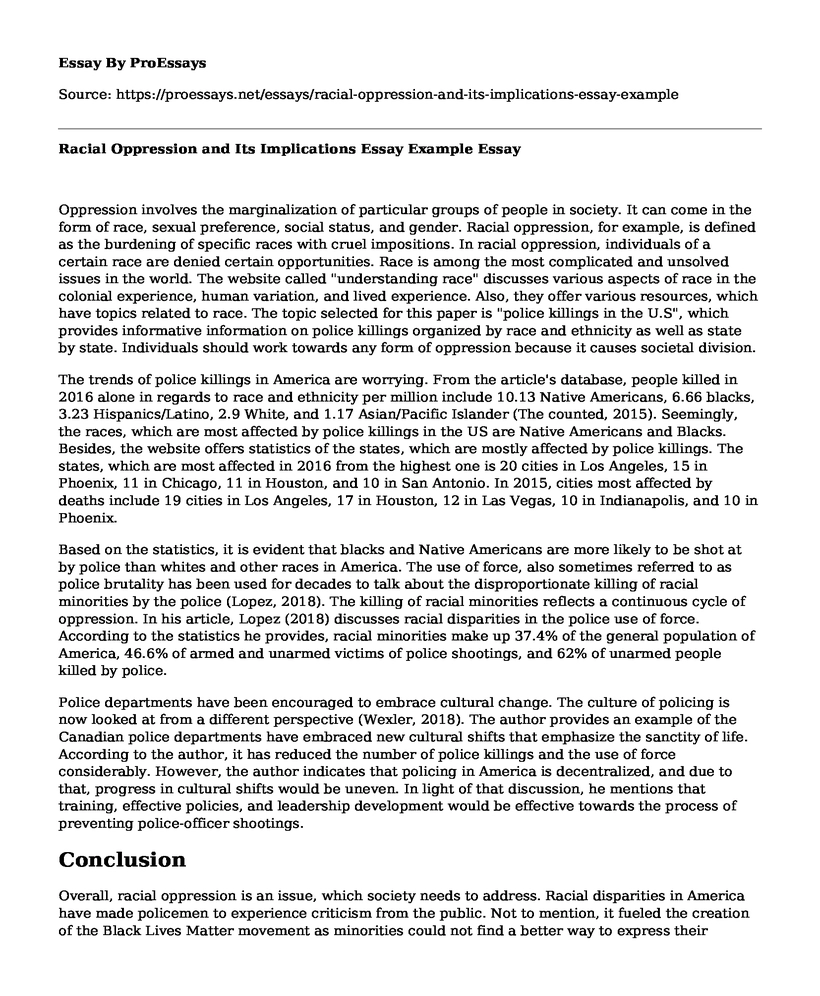Oppression involves the marginalization of particular groups of people in society. It can come in the form of race, sexual preference, social status, and gender. Racial oppression, for example, is defined as the burdening of specific races with cruel impositions. In racial oppression, individuals of a certain race are denied certain opportunities. Race is among the most complicated and unsolved issues in the world. The website called "understanding race" discusses various aspects of race in the colonial experience, human variation, and lived experience. Also, they offer various resources, which have topics related to race. The topic selected for this paper is "police killings in the U.S", which provides informative information on police killings organized by race and ethnicity as well as state by state. Individuals should work towards any form of oppression because it causes societal division.
The trends of police killings in America are worrying. From the article's database, people killed in 2016 alone in regards to race and ethnicity per million include 10.13 Native Americans, 6.66 blacks, 3.23 Hispanics/Latino, 2.9 White, and 1.17 Asian/Pacific Islander (The counted, 2015). Seemingly, the races, which are most affected by police killings in the US are Native Americans and Blacks. Besides, the website offers statistics of the states, which are mostly affected by police killings. The states, which are most affected in 2016 from the highest one is 20 cities in Los Angeles, 15 in Phoenix, 11 in Chicago, 11 in Houston, and 10 in San Antonio. In 2015, cities most affected by deaths include 19 cities in Los Angeles, 17 in Houston, 12 in Las Vegas, 10 in Indianapolis, and 10 in Phoenix.
Based on the statistics, it is evident that blacks and Native Americans are more likely to be shot at by police than whites and other races in America. The use of force, also sometimes referred to as police brutality has been used for decades to talk about the disproportionate killing of racial minorities by the police (Lopez, 2018). The killing of racial minorities reflects a continuous cycle of oppression. In his article, Lopez (2018) discusses racial disparities in the police use of force. According to the statistics he provides, racial minorities make up 37.4% of the general population of America, 46.6% of armed and unarmed victims of police shootings, and 62% of unarmed people killed by police.
Police departments have been encouraged to embrace cultural change. The culture of policing is now looked at from a different perspective (Wexler, 2018). The author provides an example of the Canadian police departments have embraced new cultural shifts that emphasize the sanctity of life. According to the author, it has reduced the number of police killings and the use of force considerably. However, the author indicates that policing in America is decentralized, and due to that, progress in cultural shifts would be uneven. In light of that discussion, he mentions that training, effective policies, and leadership development would be effective towards the process of preventing police-officer shootings.
Conclusion
Overall, racial oppression is an issue, which society needs to address. Racial disparities in America have made policemen to experience criticism from the public. Not to mention, it fueled the creation of the Black Lives Matter movement as minorities could not find a better way to express their concerns. Racial oppression has adverse implications as it interferes with the physiological and psychological state of a person. It is believable that as a society, people can live in harmony regardless of their race or ethnicity. Police and Sheriff Departments should be willing to embrace cultural shifts because it would reduce complaints of killings and brutality among minority groups significantly. Most importantly, the trump administration has to address racial disparities and put it at the top of its national agenda.
References
Lopez, G. (2018). There are huge racial disparities in how US police use force. Vox. Retrieved from https://www.vox.com/identities/2016/8/13/17938186/police-shootings-killings-racism-racial-disparities
The Counted. (2015). People killed by Police in the US. The Guardian. Retrieved from https://www.theguardian.com/us-news/ng-interactive/2015/jun/01/the-counted-map-us-police-killings
Wexler, C. (2018). What it will take to reduce deadly shootings by police? The Washington Post. Retrieved from https://www.washingtonpost.com/outlook/what-it-will-take-to-reduce-deadly-shootings-by-police/2018/01/19/003df822-f65e-11e7-a9e3-ab18ce41436a_story.html?utm_term=.a03162b9c405
Cite this page
Racial Oppression and Its Implications Essay Example. (2022, Dec 10). Retrieved from https://proessays.net/essays/racial-oppression-and-its-implications-essay-example
If you are the original author of this essay and no longer wish to have it published on the ProEssays website, please click below to request its removal:
- Research Paper on Sexual Harassment
- Essay on Union Bargaining
- Ramifications of Biased Media Coverage Paper Example
- Article Analysis Essay on City of Women
- Case Study on Substance Abuse Disorder: Examining Kyle's Unusual Behavior
- Racism: Prejudice, Restrictions & Denial of Rights - Essay Sample
- Essay Example on Women's Fight for Gender Equality in the Workplace







